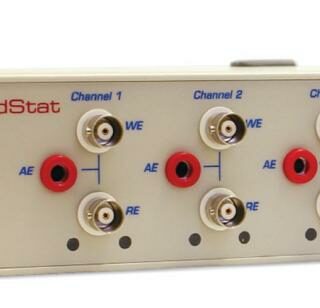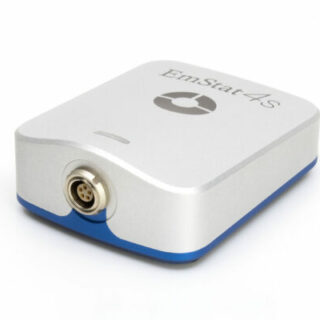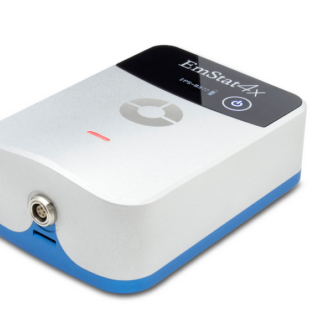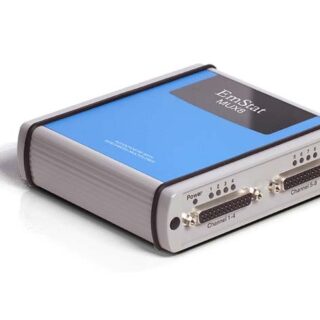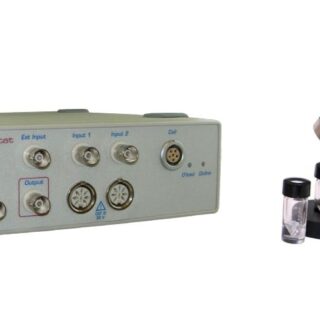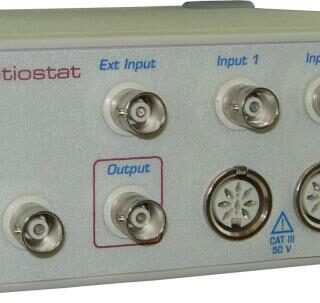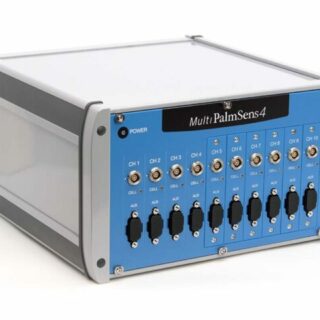Category
- CUSTOMER SERVICES
- NEW PRODUCTS
- Sensors and electrodes
- Custom made and Modified Screen Printed Electrodes
- Stirrers
- Cables and connectors
- Cell
- Potentiostats
- Manual Screen Printer
- Minithermostat
- Pumps
- Accessories
- Kits & Sets
- Discounted SPEs (at a reduced price with visual defects/inconsistancies, but fully functional)
Category: Potentiostats
Potentiostats
BVT is an authorised distributor of wide range of handheld Potentiostats, Galvanostats and EIS Analyzers from companies PalmSens BV, eDAQ Pty Ltd., BASi and WonATech Co., Ltd.
Customers can order these products directly from BVT in the same price.
https://www.palmsens.com/products-2/
https://www.edaq.com/potentiostats-for-electrochemistry
https://www.basinc.com/epsilon/eclipse
http://www.wonatech.com/
http://www.solarbiotec.com/ ( https://galvanoplot.com/ )
Showing 1–16 of 22 results
-
8/16-Channel Potentiostat for High Resolution Data Logger
Read moreThe device consists of a combination of an multi-channel potentiostat/converter (BVT Technologies) and an external USB Pico ADC high resolution data logger (Pico Technology).
The data logger can be supplied in two versions: ADC-20 (20 bits, 8 channels) or ADC-24 (24 bits, 16 channels). For detailed specifications, see the attachment at the end of the document. The device allows measurements from up to 8 or from up to 16 independent channels. The basic output signal is a voltage in the range of -2.5 to 2.5 V. All channels are programmable (the output can be concentration, temperature, pressure…).
After connecting the device to a PC with Pico Technology’s Picolog 6 measurement program installed, the voltage [V] can be processed using math channels and directly recorded in real time as temperature, current, resistance, frequency, % and pressure, see measurement example at the end of the document.
For temperature measurement, the device is compatible with resistance thermometers (Ni 1000, Ni 5000, Pt 1000. Power is provided via USB-B, the maximum electrical consumption of the device is 500 mA.
Device Usage
- Temperature measurement with different temperature sensor (resistance thermometers Ni 1000, ni 5000, Pt 1000)
- Voltage measurement
- Conductivity and resistance measurement
- Amperometry measurement
* For this product, we recommend our customers use the Training Service from BVT.
(https://bvt.cz/produkt/offer-of-long-term-automated-measurements-on-bvt-apparatus/)
-
EA163 Potentiostat
Read more- Modular potentiostat
- 4 modes: potentiostat, galvanostat, ammeter and voltmeter
This modular potentiostat is perfect for cyclic voltammetry and electroanalytical chemistry, and can use two (working and counter), or three (working, auxiliary and reference) electrodes. It can also operate as a galvanostat, ZRA (zero resistance ammeter), and high impedance voltmeter. It must be used together with any e-corder model.
The bandwidth of the EA163 is 100 kHz and so it is suitable for use with the Z100 Electrochemical Impedance Analyzer.
More information can be found through the link: https://www.edaq.com/EA163
-
EA164 QuadStat
Read more- Four-channel potentiostat 10mA to 200pA range
- Separate/common reference and auxiliary electrodes
- BiPotentiostat
- Ideal for amperometric biosensors, microbial fuel cells, photovoltaic materials and neurochemistry
The QuadStat is a software-controlled four-channel potentiostat with many Research Advantages (see below). Each channel can be used as a single three-electrode potentiostat. Alternatively two (bipotentiostat), three, or four working electrodes can be used in a single reaction chamber with a common reference and auxiliary electrode. Potential at each working electrode can be independently adjusted between ±2.5 V, or by using an external waveform generator to between ±10 V. The QuadStat can measure currents from pico- to milliamperes, making it ideal for amperometric biosensor research including use as a multichannel monitor for in vivo nitric oxide or dissolved oxgen sensors.
Two QuadStats can be ‘piggybacked’ to provide eight potentiostat channels.
By connecting the corresponding auxiliary and reference electrode leads, the QuadStat can be used as a four channel two-electrode (working and counter electrode) potentiostat. There is also a zero resistance ammeter (ZRA) mode of operation on each channel.
More information can be found through the link: https://www.edaq.com/EA164
-
EA362 Dual PicoStat
Read more- High sensitivity 2 channel potentiostat
- Bipotentiostat and 4-electrode modes of operation
The Dual PicoStat is a two channel high sensitivity potentiostat suitable for use with carbon fiber and ultramicroelectrodes for the monitoring of low current signals (down to picoameperes). It is commonly used for in vivo monitoring of dopamine by amperometry.
There are two potentiostat channels which enable the unit to also be used as a bipotentiostat (two working electrodes with a common reference and auxiliary electrode) so that dopamine levels can be monitored at two separate locations. Alternatively it can be used to perform duplicate experiments with separate samples, each with a working, reference and auxiliary electrode.
It can also be used as a 4-electrode voltage clamp (with two current passing and two voltage sensing reference electrodes) for studies of ionic transport across membranes or immiscible interfaces.
The Dual PicoStat is electrically isolated and is resistant to interference from neural stimulators, and ground loops. It is DC powered and can be used inside Faraday cages if required.
More information can be found through the link: https://www.edaq.com/EA362
-
EmStat4R
Read moreThe EmStat4R delivers desktop performance in a rugged enclosure. The EmStat4R is a portable Battery or USB-powered Potentiostat, Galvanostat, and optional a Frequency Response Analyzer (FRA) for Electrochemical Impedance Spectroscopy (EIS).
The EmStat4R is great for applications that require low currents, from 30 mA down to picoamps, such as sensor applications. The EmStat4R is controlled with PSTrace for Windows, the Android app PStouch, or you can write your own MethodSCRIPT and control it from any platform or operating system.
More information can be found through the link: https://www.palmsens.com/product/emstat4r/
- Portable: battery, Bluetooth and rugged housing
- Available with connection module for sensor cable or SPE
- Potential range ±3 V
- Max. current ±30 mA
- Optional impedance analyzer: 10 μHz up to 200 kHz
Two versions
The EmStat4R is available with a cell cable or SPE connection module. Both versions can be configured with optional EIS/FRA with a maximum frequency of 200 kHz. See specifications for more information.
EmStat4R SNS EmStat4R SPE 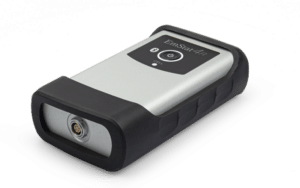
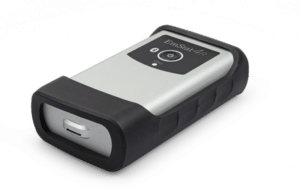
Connection module Cell cable Connection module Screen-printed-electrode Cell cable included Yes Cell cable included No Electrode connections WE, RE, CE and ground Electrode connections RE, WE, CE Connectors 2 mm banana Sensor pitch 2.54 mm Maximum sensor width 11 mm Allowed sensor thickness Between 0.1 mm and 0.8 mm Always a backup
The EmStat4R is equipped with 500 MB internal storage memory for storing your measurements as a backup. All internally stored measurements can be browsed and transferred back to the PC easily using the PSTrace software for Windows. Your data is always with your instrument wherever you take it.
Standard included
A standard EmStat4R includes a rugged carrying case with:

- EmStat4R
- Rugged case
- USB-C cable
- Cell cable: high quality, double-shielded cable with 2 mm banana connectors for Working, Counter, Reference electrode and Ground
- 4 crocodile clips
- Dummy Cell
- PSTrace software for Windows (on USB drive)
- Manual (hardcopy)
- Quick Start document
- Calibration report
- Three year warranty
-
EmStat4S
Read moreThe EmStat4S delivers desktop performance in the palm of your hand. The EmStat4S is a portable USB-powered Potentiostat, Galvanostat, and optional a Frequency Response Analyser (FRA) for Electrochemical Impedance Spectroscopy (EIS). The EmStat4S is controlled with PSTrace for Windows, or you can write your own MethodSCRIPT and control it from any platform or operating system.
More information can be found through the link: https://www.palmsens.com/product/emstat4s/
Versions
The EmStat4S comes in two different versions:
- Low Range: for lower currents and potentials
- High Range: for higher currents and potentials
Both versions can be configured with optional EIS/FRA with a maximum frequency of 200 kHz.
Main differences between the EmStat4S Low and High Range 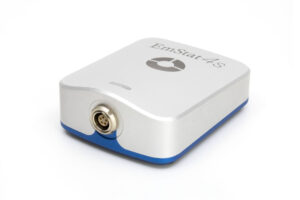
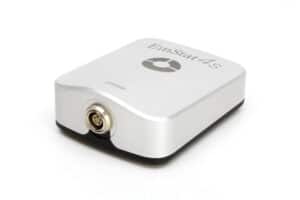


Potential range ±3 V ±6 V Max. compliance voltage
±5 V ±8 V Current ranges 1 nA to 10 mA (8 ranges) 100 nA to 100 mA (7 ranges) Max. current ±30 mA ±200 mA Electrode connections WE, RE, CE and ground,
2 mm banana plugsWE, RE, CE, Sense, and ground,
2 mm banana plugsStandard included
A standard EmStat4S includes a rugged carrying case with:
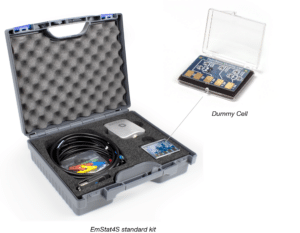
- EmStat4S
- USB-C cable
- Sensor cable: high quality, double-shielded cable with 2 mm banana connectors for Working, Counter, Reference electrode and Ground
- 4 or 5 crocodile clips
- Dummy Cell
- PSTrace software for Windows (on USB drive)
- Manual (hardcopy)
- Quick Start document
- Calibration report
-
EmStat4X
Read moreThe EmStat4X delivers high performance in a small footprint. The EmStat4X is a small battery and USB-powered Potentiostat, Galvanostat, and optional Frequency Response Analyser (FRA) for Electrochemical Impedance Spectroscopy (EIS).
The EmStat4X Low Range (LR) version is great for applications that require measuring low currents down to picoamps, like (bio)sensor research. The High Range (HR) version is very suitable for applications that need a maximum current of up to 200 mA. The EmStat4X is controlled with PSTrace for Windows, or you can write your own MethodSCRIPT and control it from any platform or operating system.
More information can be found through the link: https://www.palmsens.com/product/emstat4s/
The EmStat4X LR and HR features include:
- Fast EIS support: for running fixed-frequency EIS measurements at a very low interval of around 1 ms.

- Auxiliary Port: for connecting to a MUX8-R2 multiplexer, temperature sensor, pH sensor, stirrer control, triggering and more.
- iR compensation: to compensate for the iR drop between the Reference electrode and the outside of the double layer of the electrochemical cell.
- Bluetooth: for a wireless connection to a PC, smartphone or tablet
- 11.1 Wh battery: for more than 8 hours of continuous measurements (typical with the LR).
- Small borderless display: showing the state of the battery and connectivity.
Two versions
The EmStat4X comes in two different versions:
- Low Range: for lower currents and potentials (±30 mA / ±3 V applied / ±5 V compliance)
- High Range: for higher currents and potentials (±200 mA / ±6 V applied / ±8 V compliance)
Both versions can be configured with optional EIS/FRA up to 200 kHz.
See specifications for a detailed comparison between the LR and HR.Always a backup
The EmStat4X is equipped with 500 MB internal storage memory for storing your measurements as a backup. All internally stored measurements can be browsed and transferred back to the PC easily using the PSTrace software for Windows. Your data is always with your instrument wherever you take it.
Standard included
A standard EmStat4X includes a rugged carrying case with:
- EmStat4X LR or HR
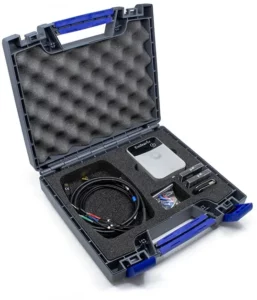
- USB-C cable
- Cell cable: high quality, double-shielded cable with 2 mm banana connectors for Working, Counter, Reference electrode and Ground, 1 meter long
- 4 or 5 crocodile clips
- Dummy Cell
Also included:
- PSTrace software for Windows (on USB drive)
- Manual (hardcopy)
- Quick Start (hardcopy)
- Calibration report
- Fast EIS support: for running fixed-frequency EIS measurements at a very low interval of around 1 ms.
-
EmStatMUX8-R2
Read moreUSB powered potentiostat with integrated multiplexer
- potentiostat with integrated 8 channel multiplexer
- potential range: ± 3V or ± 4V
- compliance voltage: ± 5V or ± 8V
- current ranges: 1 nA – 100 mA
- maximum current: ± 100 mA
With the EmStat3MUX8-R2 you can connect arrays or other setups made of up to eight working electrodes in two or three electrode cell types. If more channels are required, one or more MUX-R2 can be stacked to the EmStatMUX8-R2 for a total of up to 128 channels.
The potentiostat is controlled as well as powered by USB and is used with PSTrace. The MUX8-R2 can sample different cells at a rate of 25 ms/cell. Usually a method needs to be finished to switch the cell but the fast sampling per cell makes it possible to measure time depending techniques, e.g. chronoamperometry, practically simultaneously. Via the script window of PSTrace it is also possible to perform a different experiment on each of the channels sequentially.
More information can be found through the link: https://www.palmsens.com/product/emstatmux/
Specifications
With EmStat potentiostat version 3 3+ dc-potential range
± 3.000 V ± 4.000 V compliance voltage
± 5 V ± 8 V dc-potential resolution 0.1 mV 0.125 mV dc-potential accuracy 0.2 % 0.3 % current ranges
1 nA to 10 mA (8 ranges) 1 nA to 100 mA (9 ranges) maximum current ± 20 mA typical
and ± 15 mA minimum± 100 mA typical The current is measured using a zero resistance ammeter (ZRA).
Cell connections
There are four ways to connect your sensor. These sensor connections are quoted separately.
- Option A: Double shielded sensor cables with 2 mm banana connectors. The 2 mm banana connectors are compatible with standard croc clips (they will be included in the quotation as optional).
- Option B: High-density cable that terminates in ferrules
- Option C: Connection (Screw) Terminal to assemble your own wires.
- Option D: Screen Printed Electrode Connector
Each of these connection options can be used to connect 4 channels. When you add the EmStatMUX8 in the quotation basket we will make sure to include two units of the selected connection option so you can connect all 8 channels to the electrochemical cells.
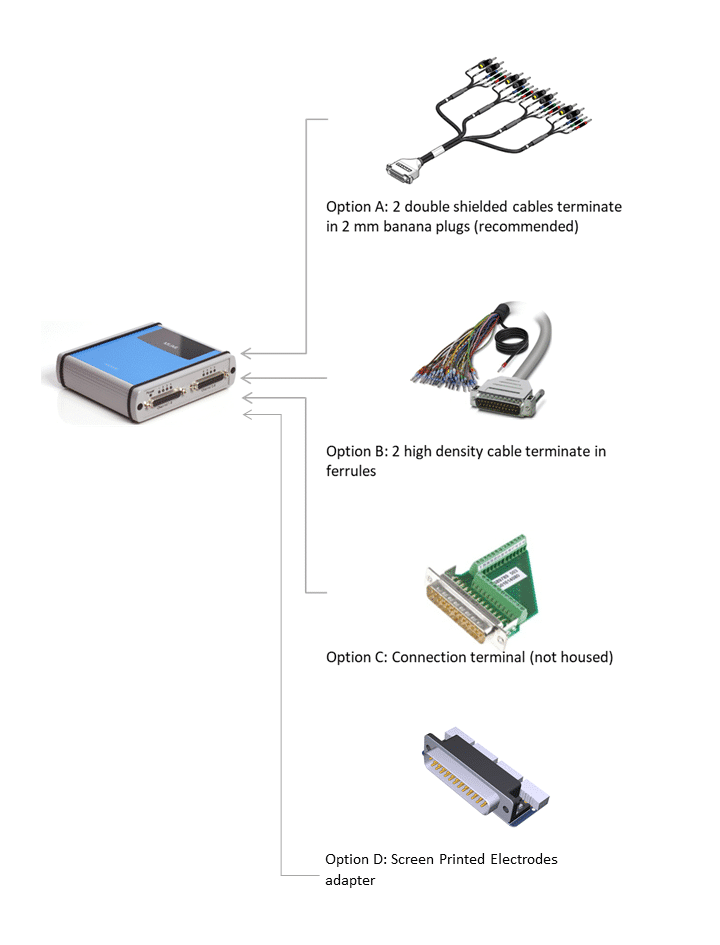
-
Epsilon EClipse
Read moreThe Epsilon EClipse is the latest electrochemical analyzer manufactured by BASi.
It is a potentiostat/galvanostat with a second working electrode for bipotentiostat measurements. Software with the most popular electrochemistry techniques is included with the instrument.
More information can be found through the link: https://www.basinc.com/epsilon/eclipse
This System Includes:
- Basic Software – techniques include
- Cyclic Voltammetry/Linear Sweep Voltammetry
- Chronoamperometry/Chronocoulometry
- Controlled Potential Electrolysis
- DC Potential Amperometry
- Open Circuit Potential vs. Time
- Chronopotentiometry
- Basic Plus Software – techniques include
- Sampled Current Polarography
- Normal Pulse Voltammetry/Polarography
- Differential Pulse Voltammetry/Polarography
- Square Wave Voltammetry
- Stripping Voltammetry Techniques
- Double Potential Step Chronopotentiometry
- Methods Software – techniques include
- Prepare sequences with an unlimited number of techniques
- Insert trigger and delays in sequence
- Repeat sequence up to 9999 times
- Bi-Potentiostat – techniques include
- Multi-Channel Amperometry
- Multi-Channel Cyclic Voltammetry
- Multi-Channel Chronoamperometry
10’ USB Cable
Bi-Potentiostat cell lead cableSpecifications:
Potentiostat
- Channel 1 applied potential: Dynamic DAC: 16 bit, ±3.275 V @ 0.1 mV resolution or ±10 V @ 0.33 mV resolution
- Offset DAC: 8 bit, ±2.55 V @ 10 mV resolution
- Channel 2 applied potential: Dynamic DAC: 8 bit, ±2.55 V @ 10 mV resolution
- Compliance voltage: ±12 V
- Maximum current: 100 mA
- Bandwidth: > 100 kHz
- Bias current: < 1pA
- Electrometer input impedance: > 1012W
- (values for parameters other than applied potential are for both channels)
Current-to-voltage converter
- Full scale sensitivity: 1 nA*, 10 nA*, 100 nA, 1 µA, 10 µA, 100 µA, 1 mA, 10 mA,100 mA, (*secondary gain used)
- Secondary gain: x1, x10, and x100
- ADC resolution: 16 bit
- Sampling rate: 50 kHz (20 µs/conversion)
- Data length: up to 64k points – fast
Galvanostat
- Applied current: 50 pA – 50 mA
- Range: ±10 V ± 1 V
- Measured potential resolution: 0.02 mV
- Max leakage current: 30 pA
I/O
- Eout (applied potential)
- Iout (current to voltage output)
- Ein (input connection for external applied wave form)
- Cell Stand port (control of C-3 Cell Stand and CGME)
- Ordering Port (control of RDE-2)
- PC (USB) port
- Trigger out (TTL)
Minimum PC requirements
- Win 7 or higher
- Pentium III
- 512 MB RAM
- 50 MB hard drive space available
- USB port
Power requirements
- 120 or 240 VAC, 50/60 Hz, 60 VA
Dimensions & weight
- 15.75″ (40 cm) x 5.25″ (13 cm) x 12.75″ (32.5 cm)
- 17.5 lb (7.4 kg) (1 channel)
- Basic Software – techniques include
-
ER461 EChem Startup System
Read moreMost popular eDAQ potentiostat
Potentiostat, galvanostat, ZRA and electrometer modes
Maximum 100 mA and ±10 VOpen your lab to the world of electrochemistry with the economically priced EChem Startup System. It has just about everything you need for most voltammetric experiments. The system is ideal for both research and teaching experiments, and especially for compound characterization with cyclic voltammetry.
More information can be found through the link: https://www.edaq.com/ER461
System Components:
• ER466 Integrated Potentiostat System
• ET014 EChem Electrode Kit
• ES260 EChem Software
• ES500 Chart and Scope SoftwareThe ER466 Integrated Potentiostat System is our most popular potentiostat model, being ideal for cyclic, linear sweep, and most analytical pulse voltammetric experiments, either in the research or teaching laboratory. It also functions as a galvanostat, ZRA (zero resistance ammeter), and high impedance voltmeter (electrometer). Connection to a computer is via a USB cable.
The EChem Electrode Kit contains gold, platinum and glassy carbon working disk electrodes. Reference and auxiliary electrodes are also included, together with two 3 mL reaction vials and a stand. The electrodes are suitable for use with the eDAQ potentiostats, and can be used in a variety of electrochemical applications.
Working electrodes, 1 mm disk, PEEK body:
ET074-1 Glassy carbon
ET075-1 Platinum
ET076-1 GoldReference electrode: ET072 Leakless Ag/AgCl
Auxiliary electrode: ET078-1 Pt coated titanium rod, 1.6 mm diameter
Two 3-mL reaction vessels with stirrer vane, drilled PTFE gasket and holder
Lead wire clampAvailable Techniques:
• Cyclic Voltammetry
• Linear Sweep Voltammetry *
• Square Wave Voltammetry *
• Normal Pulse Voltammetry *
• Differential Pulse Voltammetry *
• Multi Pulse Voltammetry
• Multi Pulse Amperometry
• Chronoamperometry (single or multistep)
• Chronocoulometry (single or multistep)
• Chronopotentiometry (single or multistep)
• Controlled potential electrolysis
• Controlled current electrolysis* Also available in stripping mode for trace element determination. Metals such as copper, lead, cadmium and zinc can be determined in the ppb range even in an undergraduate lab (no clean room required!).
Battery technology, corrosion science, conducting polymer and electrosynthesis experiments can also be performed. -
ER466 Integrated Potentiostat System
Read more- Ideal for cyclic voltammetry, linear sweep and pulse techniques
- Potentiostat, galvanostat, ammeter and voltmeter modes
- Maximum 100 mA and ±10 V
- Expandable using isoPod amplifiers
- High accuracy
- Windows 7, 8 and 10 compatible
The ER466 Integrated Potentiostat System is our most popular potentiostat model, being ideal for cyclic, linear sweep, and most analytical pulse voltammetric experiments, either in the research or teaching laboratory. It also functions as a galvanostat, ZRA (zero resistance ammeter), and high impedance voltmeter (electrometer). Connection to a computer is via a USB cable.
More information can be found through the link: https://www.edaq.com/ER466
-
ER467 High Current Potentiostat
Read more- Ideal for cyclic voltammetry, linear sweep and pulse techniques
- Potentiostat, galvanostat, ammeter and voltmeter modes
- Maximum 1 amp and ±10 V
- Expandable using isoPod amplifiers
- Four-electrode potentiostat
- Windows 7, 8 and 10 compatible
The ER467 Potentiostat System is ideal for cyclic, linear sweep, and most analytical pulse voltammetric experiments, either in the research or teaching laboratory. It also functions as a galvanostat, ZRA (zero resistance ammeter), and high impedance voltmeter (electrometer). Connection to a computer is via a USB cable.
More information can be found through the link: https://www.edaq.com/ER467
-
MPH 472 Universal Potentiostat
Read moreThe instrument enables measurement of amperometry, potentiometry and conductometry. Communication with the computer is provided via USB or Bluetooth. This hand-held device is equipped with GPS navigation so the measured data may be enhanced by the exact coordinates of the location where the measurement was made.
Measured data can be stored and later processed in a PC because of the SD card slot incorporation. The ability to record a waveforms or integrate the measure values is enabled. Basic evaluation methods are also implemented – linear and non-linear calibration and standard addition method is available. The influence of the type of oxygen electrode membrane, temperature or gas solubility can be compensated for the measured values.
The measured data are automatically recalculated and displayed in units of current, voltage, concentration (g∙L-1 or mol∙L-1) or saturation. Potentiometric measurement allows connection of pH electrodes and ISE.
Key Properties
- Up to 200 hours of battery life depending on the operating mode.
- Excellent analytical tools (graphs, unit conversions, internal standard method for potentiometry, coulometric titration, 10 Henry’s constants for various redox active gases).
- Power supply and data communication via USB, possibility of connection via Bluetooth.
- Data logging to memory card.
- Up to 5-point calibration for ISE and pH electrodes.
- Up to 4-point calibration of the conductivity cell makes it possible to compensate the non-linearity of the measurement.
- GPS equipment enables measurements in the field with location storage.
- Calibration stored separately in the device (possibility of changing the memory card without having to recalibrate the device).
- Possibility of separate calibration for 4 probes for amperometry and potentiometry.
- The possibility of using different temperature sensors (PT100, PT1000, Ni1000, ATC Monocrystals).
- Advanced power management (display sleep and automatic device shutdown can be set according to the user’s preferences
- Vector voltmeter for accurate conductivity measurement.
- Powerful thirty-two-bit microprocessor for accurate measurement calculations.
Improvements:
- Faster battery charging via USB charger.
- Vector voltmeter for precise conductometric measurement.
- A more sensitive GPS module.
- More robust input circuits for ametrometric measurement – less susceptible to noise.
More information can be found through the link: https://www.monokrystaly.cz/cs/ph-mv-ion-metry.html?fbclid=IwAR3ieir-mH-D10LZ-SZkrx74OHZYvOHjZPnOX8nfi9WdcwostsUgTAVaZPM#MPH471
-
MultiEmStat4
Read moreThe MultiEmStat4 is a compact Potentiostat, Galvanostat, and optional Frequency Response Analyser (FRA) for Electrochemical Impedance Spectroscopy (EIS) with 8 or 12 channels. The MultiEmStat4 comes in two versions; the Low Range version is great for applications that require a low current range down to 1 nA, whereas the High Range version is very suitable for applications that need a maximum current of 200 mA.
The MultiEmStat4 is controlled with MultiTrace for Windows, or you can write your own MethodSCRIPT and control it from any platform or operating system.
- Available with 8 or 12 channels
- FRA / EIS: 10 μHz up to 200 kHz
- Potential range: ±3 V (LR) or ±6 V (HR)
- Max. current: ±30 mA (LR) or ±200 mA (HR)
More information can be found through the link: https://www.palmsens.com/product/multi-emstat4/
Always a backup
The MultiEmStat4 is equipped with 500 MB internal storage memory on each channel for storing your measurements as a backup. All internally stored measurements can be browsed and transferred back to the PC easily using the MultiTrace software. Your data is always with your instrument wherever you take it.
Synchronizing channels in Synched mode
By enabling synchronization of channels and adjusting the setup of your cables, you can use the MultiEmStat4 as a polypotentiostat. This means you can use multiple working electrodes, one counter and one reference electrode in the same cell at the same time. Your working electrodes all perform the same measurement.
Specifications
The MultiEmStat4M is available in two versions: the LR (Low Range) and HR (High Range) version.
Main differences between the MultiEmStat4 Low and High Range 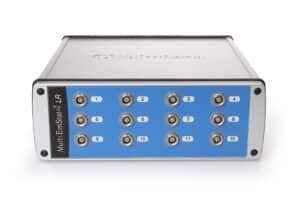
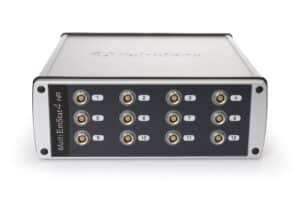


Potential range ±3 V ±6 V Max. compliance voltage ±5 V ±8 V Current ranges 1 nA to 10 mA (8 ranges) 100 nA to 100 mA (7 ranges) Max. current ±30 mA ±200 mA Electrode connections WE, RE, CE and ground,
2 mm banana plugsWE, RE, CE, Sense, and ground,
2 mm banana plugsHardware options - EIS up to 200 kHz
- Galvanic Isolation
- EIS up to 200 kHz
- Galvanic Isolation
-
MultiPalmSens4
Read moreMulti-channel Potentiostat / Galvanostat / Impedance Analyzer
- 4 to 10 channels available in different configurations
- FRA / EIS: 10 μHz up to 1 MHz
- 9 current ranges: 100 pA to 10 mA
- potential range: ±5 V or ±10 V
The MultiPalmSens4 is a flexible multi-channel potentiostat, galvanostat and impedance analyzer which you can fully tailor to your requirements and budget. The MultiTrace software allows for using each channel individually or simultaneously or running a sequence of automated tasks on each channel. Each channel provides an additional auxiliary port for controlling peripherals or monitoring temperature or other analog signals.
More information can be found through the link: https://www.palmsens.com/product/multipalmsens4/
Configure your ideal multi-channel potentiostat
Each channel can be configured with:
- ±5 V or ±10 V maximum potential range
- EIS/FRA with maximum frequency of 100 kHz or 1 MHz
- Bipotentiostat module for second WE
- iR-Compensation
- Galvanic isolation
Always a backup
Every channel of the MultiPalmSens4 is equipped with 8 GB storage space. This means all your measurements* can automatically be saved on-board as backup.
Measurements can be browsed and transferred to the PC easily using the MultiTrace software for Windows.Synchronizing channels in Synched mode
By enabling synchronization of channels and adjusting the setup of your cables, you can use the MultiPalmSens4 as a polypotentiostat. This means you can use multiple working electrodes, one counter and one reference electrode in the same cell at the same time. Your working electrodes all perform the same measurement.
-
MUX8-R2 Multiplexer
Read moreMultiplexer for 8 up to 128 cells
- Automatically switch between electrochemical cells
- Easy stacking with magnetic feet and top
- 4 different electrode or sensor configurations
- Daisy chain multiplexers, up to 128 channels!
The PalmSens series and the EmStat4X can be used to work with multiple working electrodes or a sensor array by means of a multiplexer.
The multiplexer switches between the working electrodes in the range of milliseconds.
- each MUX8-R2 multiplexer enables to work with up to eight 2- or 3- electrode systems.
- daisy chaining multiple MUX8-R2 boards (expansion up to 128 channels)
- all hardware settings are controlled by the software making it unnecessary to flick a physical switch
- LEDs to show which channel is selected
- allows to connect auxiliary input (like temperature sensor)
More information can be found through the link: https://www.palmsens.com/product/mux8-r2/
Connection options
The most selected connection option uses two double shielded D-Sub cables ending in 2 mm banana plugs. As alternatives we can provide a PCB with screw terminals, D-Sub cable ending in ferrules or Screen Printed Electrode Adapter. Each of these cables can be connected to 4 channels, if all 8 channels are used, two cables are needed.

Specifications
System number of channels 8 (up to 128 when daisy chained) multiplexer switches 8 x (WE, S, RE and CE) on resistance for WE 1.5 ohm typical charge injection on WE 20 pC typical leakage current < 55 pA (30 pA typical) at 25 ºC switching time 2 ms compliance voltage
± 10 V Other housing aluminium: 138 mm x 121 mm x 37 mm weight +/- 500 g temperature range 0 ºC to + 50 ºC power supply USB The MUX8-R2 has the following connectors:
Connector Function Input Y-cable connects to both potentiostat sensor connector and (digital) AUX AUX Can be used to measure auxiliary input like temperature or pH, and to switch external hardware using two digital control lines that can be set in PSTrace Link Connects to Input of next multiplexer, for daisy-chaining multiple multiplexers USB-C Input for extra power when
≥3 multiplexers are daisy-chainedChannel 1-4 Connects to sensor cables 1-4 Channel 5-8 Connects to sensor cables 5-8



